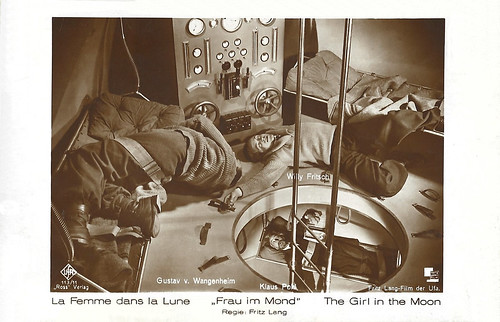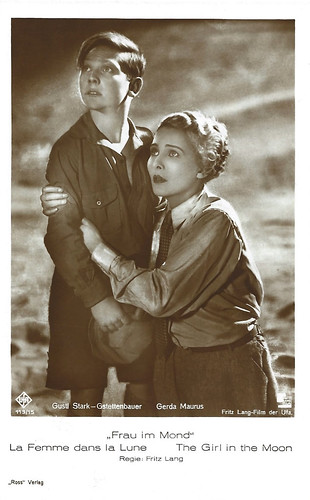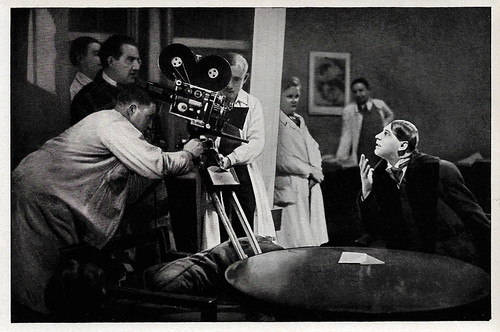
German collectors card by Ross Verlag in the series Vom Werden Deutscher Filmkunst - Der Stumme Film, picture no. 138, group 40. Photo: Ufa. Willy Fritsch, Gerda Maurus and Gustl Stark-Gstettenbauer in Frau im Mond/Woman in the Moon (Fritz Lang, 1929).

German postcard by Ross Verlag, Berlin, no. 113/2. Photo: Fritz Lang-Film der Ufa. Gerda Maurus and Gustav von Wangenheim in Frau im Mond (Fritz Lang, 1929).

German postcard by Ross Verlag, Berlin, no. 113/3. Photo: Fritz Lang-Film der Ufa. Fritz Rasp and Willy Fritsch in Frau im Mond (Fritz Lang, 1929).
Valuable information from the dark side of the Moon
Frau im Mond/Woman in the Moon (1929) was based on a novel by Fritz Lang's wife, Thea von Harbau, who had also written the script of Metropolis (Fritz Lang, 1926). The film was shot between October 1928 and June 1929 at the UFA studios in Neubabelsberg near Berlin. Similar to Metropolis, Frau im Mond is very long, running over two and a half hours. It is roughly divided into two parts, the first of which is more in the spy genre, while the second is about the launch of the moon rocket, the flight to the moon and the stay on the satellite.
At a scientific conference, Prof. Manfeldt (Klaus Pohl) presents his theory on the existence of gold on the Moon. It is greeted with laughter by the assembled academics. Thirty years later, Herr Helius (Willy Fritsch) recognises the value of Mannfeldt's work. The engineer and aeroplane hangar owner Helius has ambitious plans to build a spaceship and take it to the Moon. He and Windegger (Gustav von Wangenheim), his chief engineer, will be going, and so will Prof. Manfeldt, now living in complete poverty in the cramped attic of a house.
A gang of evil businessmen have taken an interest in Mannfeldt's theories, and they send a spy (Fritz Rasp) who identifies himself as "Walter Turner". The financiers insist that their man Turner will accompany the flight. The unmanned Rocket H 32 brings back valuable information from the dark side of the Moon. Meanwhile, Windegger has announced his engagement to Helius's other assistant, the pretty Friede (Gerda Maurus). Helius, who secretly loves Friede, avoids their engagement party.
And the financiers have a secret agenda: to control the world's gold supply... Finally, the Spaceship "Friede" is ready as it rolls out on its gantry for takeoff. The staged rocket works as planned, but the acceleration is fierce. As they approach the Moon, they discover a stowaway on board, Gustav (Gustl Stark-Gstettenbaur), a young boy. Gustav, the son of Helius' driver, had befriended Helius and has stowed away, along with his collection of science fiction pulp magazines. During the journey, Windegger emerges as a coward, and Helius's feelings for Friede begin to become known to her, creating a romantic triangle.
They reach the far side of the Moon and find it has a breathable atmosphere, per the theories of Peter Andreas Hansen, who is mentioned near the beginning of the film. Mannfeldt discovers gold, proving his theory. When confronted by Turner, Mannfeldt falls to his death in a crevasse. Turner attempts to hijack the rocket, and in the struggle, he is shot and killed. Gunfire damages the oxygen tanks, and they come to the grim realisation that there is not enough oxygen for all to make the return trip. One person must remain on the Moon.

German postcard by Ross Verlag, Berlin, no. 113/4. Photo: Fritz Lang-Film der Ufa. Mahmud Terja Bey and Borwin Walth in Frau im Mond/The Girl in the Moon (Fritz Lang, 1929).

German postcard by Ross Verlag, Berlin, no. 113/8. Photo: Fritz Lang-Film der UFA. Photo: Ufa. Klaus Pohl in Frau im Mond/Woman in the Moon (Fritz Lang, 1929).

German postcard by Ross Verlag, no. 113/9. Photo: Ufa. Gerda Maurus and Gustav von Wangenheim in Frau im Mond/Woman in the Moon (Fritz Lang, 1929).

German postcard. Ross Verlag, Berlin, no. 113/11. Photo: Fritz Lang-Film der Ufa. Willy Fritsch, Klaus Pohl, and Gustav von Wangenheim in Frau im Mond/Woman in the Moon (Fritz Lang, 1929).
One of the last great German silent films
Within the framework of the state of knowledge at the time, Fritz Lang attached great importance to a scientifically sound presentation of the technical details of launch, flight and landing as well as the lunar landscape in Frau im Mond/Woman in the Moon (1929). Lang hired German physicist Hermann Oberth as a technical advisor for the film. Noted post-war science writer Willy Ley also served as a consultant on the film. Another rocket pioneer, Rudolf Nebel, was hired by Oberth as a technical assistant, and together they constructed a two-metre-long rocket that was to be launched into the sky for promotional purposes at the premiere at the suggestion of Willy Ley, but unfortunately did not work.
When the Nazis began working on war rockets, they hired Oberth and Nebel to work on the V-2 rocket program, the later "wonder weapon" of the Second World War. Oberth also became the mentor of Wernher von Braun. The Nazis decided the rocket in Frau im Mond was too close to the truth. To preserve secrecy, they had the models destroyed and the film withdrawn from release. After World War II, Hermann Oberth followed Wernher von Braun to the United States where he participated in rocket experiments for many years. Braun later hired Oberth as technical consultant for NASA's Atlas rocket.
The first half of Frau im Mond/Woman in the Moon (1929); the set-up of the flight, the introduction to the main characters, a love triangle, and an international conspiracy is the least interesting part of the film. Once the flight begins, action tenses up and things get interesting. The best scenes of the film were created from the technical elements in combination with a good trick technique. True to the theory of astronomer Peter Andreas Hansen and scientific assumptions that were still widespread at the time, oxygen, water and gold do indeed occur on the far side of the moon in this story. Hal Erickson at AllMovie: "like many of its modern-day counterparts, more successful on a special-effects level than it is in terms of character development."
Several prescient technical and operational features are presented during the film's launch sequence, which subsequently came into common operational use during America's postwar space race. Wikipedia mentions: "The rocket ship Friede is fully built in a tall building and moved to the launch area. As launch approaches, intertitles count down the seconds from six to "now" ("now" was used for zero), and Woman in the Moon is often cited as the first occurrence of the "countdown to zero" before a rocket launch. The rocket ship blasts off submerged in a pool of water; water is commonly used today on launch pads to absorb and dissipate the extreme heat and to dampen the noise generated by the rocket exhaust. In space, the rocket ejects its first stage and fires its second stage rocket, predicting the development of modern multistage orbital rockets. The crew reclined on horizontal beds to cope with the G-forces experienced during lift-off and pre-orbital acceleration. Floor foot straps are used to restrain the crew during zero gravity."
A lunar landscape and an imposing black and white moon rocket were built in the film studio. In order to depict the lunar landscape as realistically as possible, a goods train load of 40 wagons of Baltic Sea sand was brought to the film studio for the filming. Commercially, Frau im Mond/Woman in the Moon (1929) was rather disappointing, but went down in German film history as one of the last great silent films. Several elements of the film inspired Irving Pichel's film Destination Moon (Irving Pichel, 1950), which in turn inspired the Tintin albums 'Objectif Lune'(Destination Moon, 1953) and 'On a marché sur la Lune' (Explorers on the Moon, 1943) by Belgian cartoonist Hergé. Frau im Mond/Woman in the Moon (1929) was the last blockbuster of the UFA (Universum Film AG) studio before the crash of 1929. In the 1960s, Fritz Lang was repeatedly invited as a guest of honour and speaker in the US spaceflight environment because of his innovative merits with Frau im Mond/Woman in the Moon (1929). The film was restored in 2000 by the Friedrich Wilhelm Murnau Foundation from negatives belonging to the Bundesarchiv-Filmarchiv in Berlin.

German postcard by Ross Verlag, Berlin, no. 113/13. Photo: Fritz Lang-Film der Ufa. Gerda Maurus and Willy Fritsch in Frau im Mond/Woman in the Moon (Fritz Lang, 1929).

German postcard by Ross Verlag, Berlin, no. 113/15. Photo: Fritz Lang-Film der Ufa. Gerda Maurus and Gustl Stark-Gstettenbauer in Frau im Mond/The Girl in the Moon (Fritz Lang, 1929).

German postcard by Ross Verlag, Berlin, no. 113/16. Photo: Fritz Lang-Film der UFA. Photo: Ufa. Willy Fritsch and Gustav von Wangenheim in Frau im Mond/Woman in the Moon (Fritz Lang, 1929).

German collectors card by Ross Verlag in the series Vom Werden Deutscher Filmkunst - Der Stumme Film, no. 169, Group 43. Photo: Ufa. Fritz Lang and Fritz Rasp at the set of Frau im Mond/Woman in the Moon (Fritz Lang, 1929).
Sources: Hal Erickson (AllMovie), Wikipedia (French, German and English), and IMDb.
No comments:
Post a Comment